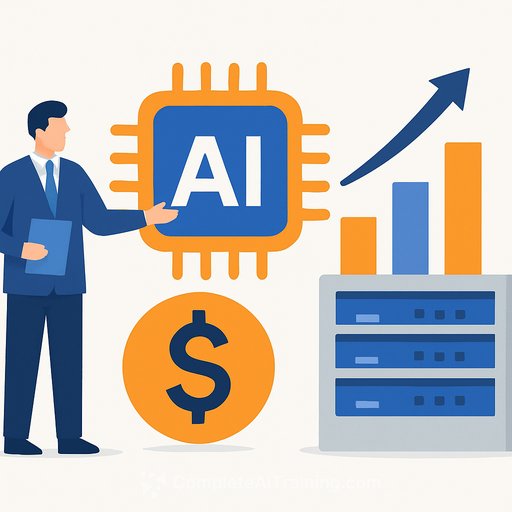Goldman Sachs targets a bigger slice of AI infrastructure financing
Goldman Sachs is building a new team inside its global banking and markets division to finance data centers and other AI infrastructure. The mandate: lend more into the sector and place that debt with investors worldwide. It's a push to capture deal flow as AI demand drives record capex for compute, power, and connectivity.
The firm's Capital Solutions Group, formed earlier this year, is already focused on sourcing and facilitating complex financings. The new effort extends that work into AI-heavy infrastructure where balance sheets, private credit, and institutional capital need coordinated deployment.
Why this matters for finance professionals
AI infrastructure has unique cash flow and risk profiles compared with traditional data center builds. High-density racks, liquid cooling, grid constraints, and fast hardware cycles change the underwriting. Sponsors need flexible capital stacks; investors want contracted revenue, step-in rights, and clear exit visibility.
Expect more structured solutions that blend bank balance sheets, private credit, infra funds, and insurance capital. Execution speed and placement depth will be a key differentiator.
Where deals are headed
- Project finance with staged drawdowns: construction loans that term out post-COD with coverage tests tied to contracted capacity.
- Holdco/OpCo splits: asset-heavy OpCo debt secured by leases and PPAs; Holdco for development and M&A flexibility.
- Lease and offtake-backed structures: long-term capacity agreements with hyperscalers to anchor investment-grade tranches.
- Private credit unitranche: speed and certainty in exchange for higher spreads and tighter covenants.
- Asset-backed and securitization options: pooling stabilized sites with diversified tenant mix and staggered maturities.
- Green/sustainability-linked features: margin ratchets tied to energy efficiency and renewable sourcing.
Key underwriting questions
- Revenue durability: term, step-downs, and termination rights in capacity or lease contracts; counterparty strength.
- Power certainty: interconnection status, queue timing, curtailment risk, PPAs, and on-site generation or storage.
- Capex and delivery: procurement for GPUs, transformers, cooling; EPC capacity; liquid cooling readiness; contingency sizing.
- Technology turnover: refresh cycles, residual values, modularity, and contractual pass-through of upgrade costs.
- Permitting and timing: local approvals, community constraints, and water usage plans.
- Security package: land, fixtures, equipment liens, assignment of offtake contracts, step-in rights, and cash sweep mechanics.
Implications for issuers
- Bring bankable anchors: contracted capacity with credible offtakers and clear expansion rights.
- Stage capital: align construction draw schedules with equipment lead times and interconnection milestones.
- Right-size covenants: DSCR/LLCR calibrated to ramp curves; cure mechanics that reflect hardware delivery risk.
- Plan for refinancing: pre-wire term takeouts or ABS options once sites stabilize.
Implications for investors and lenders
- Favor contracted, multi-tenant sites with scale and expansion potential.
- Price for grid and upgrade risk; require escalation clauses and passthroughs on energy and cooling costs.
- Build portfolios across geographies and sponsor types to diversify regulatory and supply chain exposure.
- Use step-in and replacement rights to protect against construction delays and operator underperformance.
What could accelerate deal flow
- Faster interconnection timelines and clearer utility commitments on capacity.
- Standardized offtake templates from hyperscalers and AI labs to reduce diligence friction.
- Broader appetite from insurers for long-dated, contracted cash flows.
Practical next steps
- Build a live tracker for power, land, and permits across priority regions; pair with a financing playbook by asset stage.
- Pre-negotiate common terms: assignment consents, cure periods, data center KPIs, and upgrade protocols.
- Stand up a cross-functional deal team: project finance, HY/levfin, infra equity, private credit placement, and derivatives for power hedging.
- Model refresh scenarios: performance, downtime, and capex overlays for multiple hardware cycles.
Data center energy and cooling assumptions should be evidence-based. For context on energy use and efficiency trends, see the International Energy Agency's analysis of data centers and networks here.
Stay sharp on AI and finance
If you're underwriting or structuring AI-related deals and want a quick scan of practical tooling for your day-to-day, this curated list may help: AI tools for finance.
Bottom line: a dedicated Goldman Sachs team focused on AI infrastructure financing signals deeper capital pools and faster syndication paths. Issuers that show credible power plans and contracted demand will clear markets. Investors that price upgrade and grid risk with tight documentation will find durable yield.
Your membership also unlocks:





